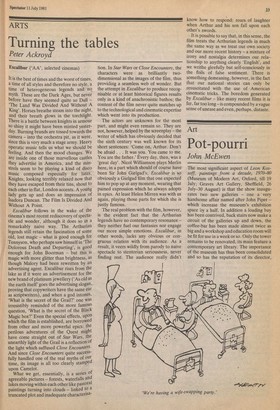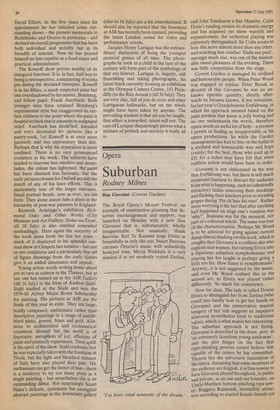Art
Pot-pourri
John McEwen
The most significant aspect of Leon Kossoff, paintings from a decade, 1970-80 (Museum of Modern Art, Oxford, till 19 July; Graves Art Gallery, Sheffield, 26 July-30 August) is that the show inaugurates two new galleries — one a very handsome affair named after John Piper — which increase the museum's exhibition space by a half. In addition a loading bay has been contrived, back stairs now make a circuit of the galleries up and down, the coffee-bar has been made almost twice as big and a workshop and education room will be fit for use in a week or so. Only the tower remains to be renovated, its main feature a contemporary art library. The importance of the museum has thus been consolidated and so has the reputation of its director, David Elliott. In the five years since his appointment he has initiated some outstanding shows — the pioneer memorials to Rodchenko and Orozco in particular — and devised an overall programme that has been both individual and notably fair in its breadth of interest. Now he has proved himself no less capable as a fund-raiser and practical administrator.
The Kossoff show proves worthy of its inaugural function. It is, in fact, half way to being a retrospective, a smattering of works pre-dating the declared timespan. Kossoff is in his fifties, a much respected artist but one overshadowed by his master, Bomberg, and fellow pupil, Frank Auerbach. Both younger men have retained Bomberg's expressionist style but exaggerated its surface richness to the point where the paint is heaped so thick that it amounts to sculptural relief. Auerbach has modelled, kneaded and eve.i decorated ilk pictures like a pastry-cook, but Kossoff is at once more painterly and less exploratory than this. Perhaps that is why his reputation is more confined. There is no very pronounced evolution in his work. The subjects have tended to become less emotive and doomladen, the colour has lightened, the paint has been churned less furiously, but the early pictures chosen for Oxford are still the match of any of his later efforts. This is particularly true of the larger canvases. Small portrait heads, now as ever, are his forte. They alone assure him a place in the hierarchy of post-war painters in England.
Kenneth Armitage's exhibition Richmond Oaks and Other Works (City Museum and Art Gallery, Stoke-on-Trent, till 18 July) is also entitled somewhat misleadingly. Here again the majority of the work dates from the last ten years — much of it displayed in his splendid oneman show at Gimpels last autumn — but one or two sculptures and a particularly fine set of figure drawings from the early Sixties give it an added dimension and appeal.
Young artists worth writing home about are as rare as salmon in the Thames, but at last one has turned up at the AIR Gallery (till 16 July) in the form of Andrew Stahl. Stahl studied at the Slade and won the 1979-81 Abbey Major Rome Scholarship for painting. His pictures at AIR are the fruits of this year in exile. They are large, boldly composed, emblematic rather than descriptive paintings in a range of uninhi bited pinks, greens, blues and gold. Allusions to architectural and ecclesiastical ornament abound but the motif is of fountains: metaphors of joy, effusions of paint and painterly experiment. Their uplift is the spirit of the show. Stahl confesses that he was especially taken with the fountains at Tivoli, but the light and bleached textures of Italy have also played their part. His enthusiasm can get the better of him — there is a tendency to try too many ploys in a single painting — but nonetheless this is an outstanding debut. Not surprisingly Susan Haire's delicate, systematic but unoriginal abstract paintings in the downstairs gallery (also to 16 July) are a bit overwhelmed. It should also be reported that the basement at AIR has recently been opened, providing the latest London venue for video and performance events.
Jacques Henry Lartigue has the extraordinary distinction of being the youngest pictorial genius of all time. The photographs he took as a child at the turn of the century will form part of the symbology of that era forever. Lartigue is, happily, still flourishing and taking photographs, his latest batch currently forming an exhibition at the Olympus Camera Centre, 151 Piccadilly (in the Ritz Arcade) (till 30 July). They are very chic, full of joie de vivre and other Lartiguean hallmarks, but on the whole might have been taken by anyone. The prevailing wisdom is that art can be taught, that effort is rewarded, talent will out. The case of Lartigue disquietingly proves what a mixture of potluck and mystery it really all is.



































 Previous page
Previous page